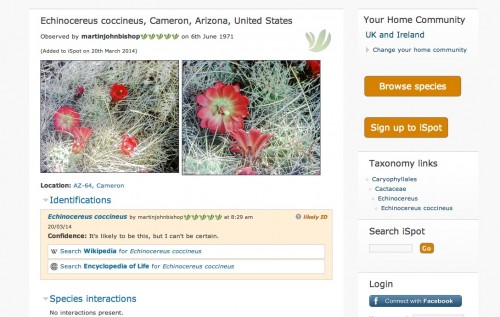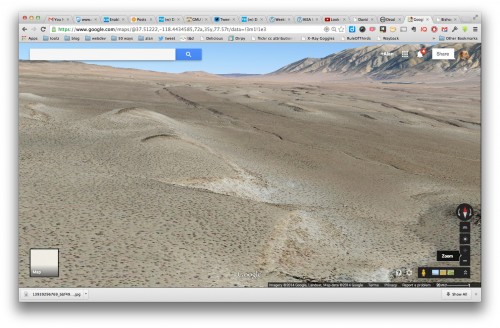In a meeting/chat this morning with Beck Pitt about her work here at the OER Research Hub, I mumbled something how these kinds of informal conversations with people and their projects more often then not ends up generating unexpected connections down the line. I see these brief meetups this week as more like potential nodes of future relevance, rather than pursuing specific research aims.
Or, it is my excuse for having vague project goals.
Like yesterday, just having lunch with Doug Clow (who has a blog title that makes me smile) there was a lot of overlap between his work on the iSpot project and my long ago start in Geology.
iSpot is what a few years ago we would have buzznamed “crowdsourcing” = described simply as “a website aimed at helping anyone identify anything in nature.” Anyone who creates an account can upload a photo of a tree, plant, pub, animal– and if they know what it is they can suggest an identification. But other site users can also confirm or disagree. There is an entire reputation system built in that cleverly helps sort out the identifications.
It’s used around the world (Doug mentioned observations submitted from Antarctica)- I found a few ones from Arizona
There’s quite a bit more to the site than I am describing- there are bioblitzes, ID guides, regional groups, local meetups. The flow of content coming in to the front page and being identified in short time is impressive.
It also directly integrates with Wikipedia as well as the amazing Encyclopedia of Life. And it reminds as well of similar sites like BugGuide (that and iSpot sure look like drupal, yes, I can admit that drupal can do nifty sites).
The beauty of iSpot the simplicity of the idea- submit a photo of something and let other people help identify it. But add to it a clever way to tap into related information, and you start growing a reference compendium. And it looks like a new variant site is sprouting up– one using the same approach to identify every British Tree. Meet… Treezilla.
And one connection spawns another; in showing me around the interaction labs here at the OU, Doug introduced me to Mark Gaved, who does a range of things one might characterize as hacking/making. Mark described the Enabling Remote Activity Project, geared to provide “opportunities for mobility impaired students to fully participate in fieldwork learning activities”. Essentially in a field study, say in the mountains of Scotland, they can use video cameras, satellite phones, local mesh networking to bring the experience to the closes place a student might be able to get to. You get a sense of Mark’s interests (this form an email)
I’m interested in hacking around with everyday resources and technologies to see if we can build low cost solutions to support learning and teaching (and social empowerment). We know that given billions, we can call ourselves NASA and send images from Mars, but what could we actually do on limited budgets that might help people and that we can share, for other people to take and run with to solve their own local issues?
My PhD came out of me wiring up two streets with Ethernet cables so my housing association (ex-squatters) could share network resources about 15 years ago ““ I found out people were doing this all over the country and internationally, and decided to have a go myself.
We had a bit of talk about other projects such as flying weather balloons over campus to teach children about remote observations, and my little experiences with the PirateBox. His newer ideas are built around the kind of portable networking that could be done in field studies to help teams working in nearby but separate areas, coordinate their findings, data collection, observations, etc.
Again I went back in time (that seems to be happening a lot lately, maybe its sign of my earning an OLD badge). But when I was doing my MS field work in Geology in 1988-1989, my advisor gave me probably the first GPS I ever saw. I tried using not to get more accurate mapping of the levels of some old lake terraces (more accurate than locating myself on a topo map). It was not easy, and did not even feel accurate.
Even the project sounds crude now. I was using false color Landsat satellite imagery to try and map field relationships of volcanic rocks, with maybe 100m ground resolution (or worse). It’s eerie to think what is possible to see and explore from the comfort of my web browser in Google Earth
Not to mention the flyover potential looking north over the Volcanic Tableland north of Bishop, a bleak terrain I walked around on for weeks collecting backpacks pull of variously welded Bishop Tuff…
Maybe my Geology degrees are coming even into more use now.
Maybe.
But more connections I make, not just PLNing or linking online, just by alking and listening… are gold.






